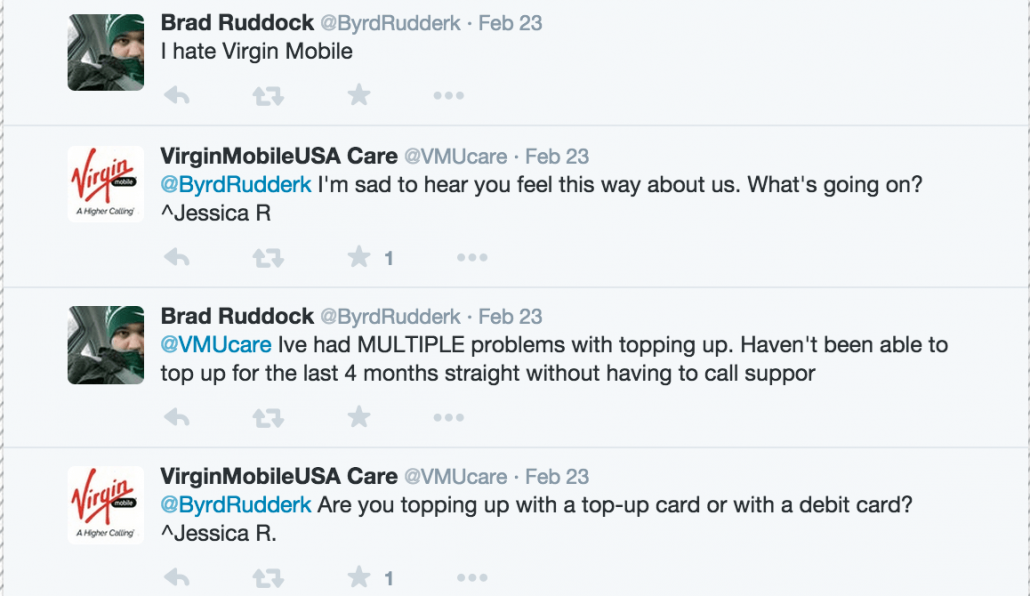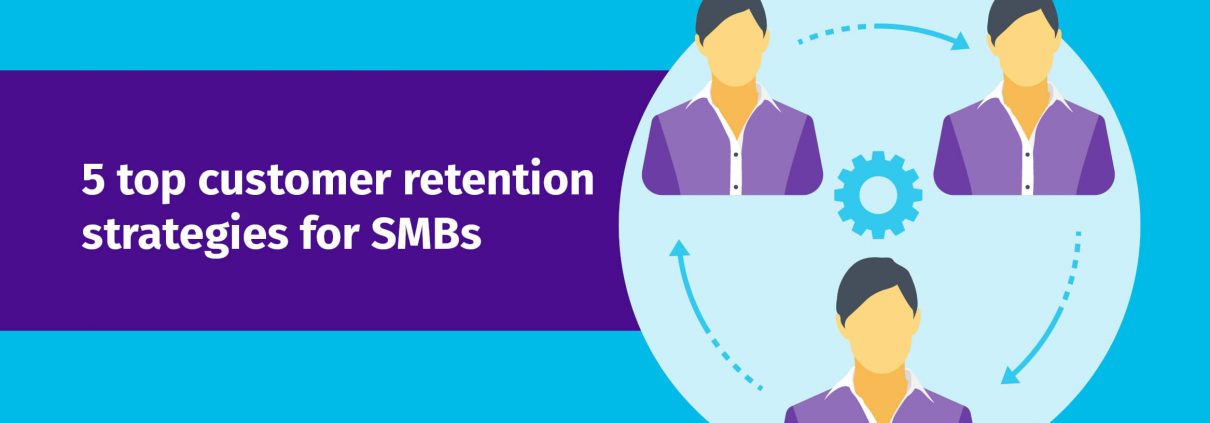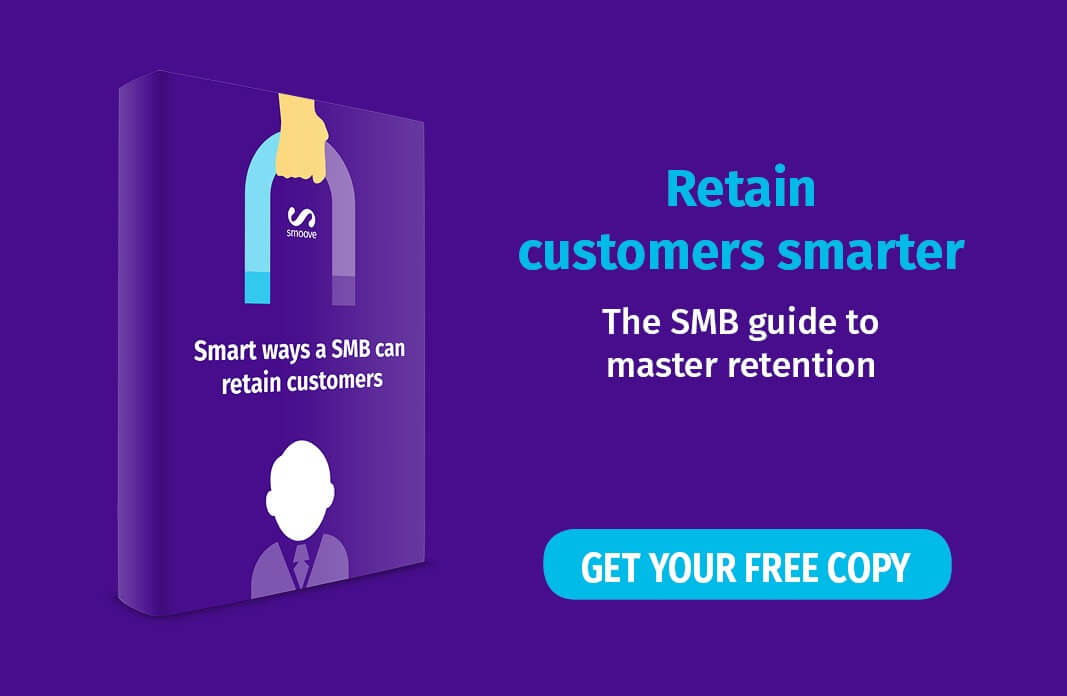5 top customer retention strategies for SMBs
Everyone knows customer retention plays a pivotal role in the success of a business, big or small. Reports in the field show that a 5% boost in customer retention could generate up to a 95% increase in company’s profitability. Existing customers are also 50% more likely to try new products from the same company and spend 31% more than the first time buyers.
Still, in order to retain your customers in a simple and effective manner, you will need to rely on the most advanced strategies out there. A simple Google search into customer retention strategies can leave the reader buried under a lot of basic information, making it hard to find useful and more advanced advice and tips on how to keep the customers.
With this in mind, we have selected the top 5 customer retention strategies for SMBs:
1. Amazing customer experience
Outstanding customer experience goes far beyond the customer being satisfied with your products or services. Today’s customers expect you to provide them with something tailored to their exact needs throughout the entire buying process. To provide the best customer experience you will need to:
- Make sure you know your customers
“Great marketing is about listening to your customers and improving their lives with your products or services. Email marketing is no different.” – Scott Cohen, Email Marketing Strategist, Marketing Copywriter, Lecturer, and Blogger at ScottWritesEverything.
This means knowing more than their email and purchase history. Let technology be your best friend once again and use it to find out what customers like / don’t like about your brand and the products or services you provide. This can be done by conducting surveys on your website, asking them an additional question on your landing page, or by interacting with the customers directly on the social media. Discuss the issues they have and always offer a solution.
A product or service-specific landing page will help you get to more data, so don’t hesitate to create multiple landing pages for multiple goals you may have. The good news is that businesses nowadays can design and publish landing pages themselves via a simple landing page builders offered by automation platforms and save both money and time usually spent on hiring professionals.

For example, in this Microsoft Office landing page, we can clearly see how successful companies use the information form to find out more than just names and emails of their customers by also asking for Country, Job Titles and Company size. By gathering other information like this, the company is able to further segment their audiences and create their marketing strategy according to it.
- Provide transparency
Think of the way you can offer your customers an insight into the progress of any service you are providing. For example be transparent in the way you do business, whether it’s a shipping process or a way you handle the complaints, and you will earn their trust.
Amazon does a great job here with its delivery tracking which customers love.

- Remove friction points and offer consistency
Friction is the worst enemy of customer experience and it can come in the form of an outdated payment technology, product unavailability, poorly designed website, long return processes and more. Identify areas of friction, act on it and be consistent across different selling channels you use. Look at the best practices in the industry and prevent losing your customers to the competition. Keep up with the ever-changing trends in business and technology and ask yourself how you can make the buying process shorter, easier and more delightful.
A good example of removing friction and developing the business in the age of technology can be shown on an example of video streaming giant Netflix. Starting in the late 90’s as a DVD rental service, Netflix recognized the need of their customers and switched to streaming movies. And that’s not all. They started developing the original content and offered the long-yearned on-demand media access to their subscribers.

2. Provide the best website and personalised experience
- The need for speed
Speeding up the website and landing pages loading time is much more important than we think. One research showed that only one-second delay in page load time can result in 11% fewer page views, 16% decrease in customer satisfaction and 7% loss in conversions. Therefore, faster loading time doesn’t only mean ranking well with Google but also has a huge impact on your company’s ability to engage with customers and make more sales. People are especially annoyed by slow loading times when reaching the websites via mobile phones, so test your website performance across all devices. Optimize the images and other content to make sure its mobile responsive.
To check the loading times of your website, go to websites such as Google Speed Test, Pingdom, or GTmetrix which all give you valuable insights on how well your site loads and provides recommendations on how to optimize it.
-
- Make it Personal
After making sure everything works properly, dedicate some time to design and execute a more personal approach to the whole buying process. Personalization brings the customer service experience into the 21st century by offering an individual experience where it matters the most and to whatever the channel you use.
Offer tailored product recommendations relevant to what visitors have previously browsed or bought and distribute it via newsletters, landing pages, SMS, and chatbots on your website and/or social media.
Swedish clothing-retail company H&M does a great job with personalizing their customer experience with an outstanding approach to the buying process. In the examples below, we can clearly see why this Facebook chatbot strategy is very popular among their customers.

Segmenting your customers and creating a personalized newsletter for a specific group of buyers is one of the best (and the cheapest) ways to both attract new customers and retain your old ones. Some of your customers may only be interested in a particular product line, some of them are your most frequent buyers but all of them will appreciate if that newsletter in their inbox is personal and diverse in content and offers.
Good news is that crafting a personalized newsletter for your business is now easier than ever. By using automation platforms that offer easy to use custom-made newsletter templates you can both save money and time. These platforms also offer you the ability to create several templates to send to different target markets and different groups of customers.
What else can you do for your customers? Run a blog! A very important step in the buying process is building trust. Having a blog which shows that you know what you’re talking about and that your business is there to solve their problems will make your customers more likely to buy from you again. With a blog, you will not only be able to showcase your products and services, but also to connect with customers through the comments and social media. A blog builds credibility for your business so keep up the momentum and reap your benefits!
For example, the e-commerce website Etsy made things very personal and it did wonders for them by showcasing the success stories coming from their community of sellers via company blog. This is how Etsy showed that their business cares and inspires many people out there to turn their talents and expertise into online businesses.

3. Focus on Life Time Value via loyalty programs
A loyalty program is an amazing opportunity to retain customers and increase customer lifetime value. It should be interesting, exciting and should spark a conversation, but above all – it needs to be unique.
In a world where numerous businesses sell similar or identical products and services, business distinction is crucial to success. If you want to stand out, you need to make your loyalty program distinctive as well, but (here is the trick!) it also must be aligned with your business.
A loyalty program has to be an extension of your brand and offer rewards not only related to your business, but to the industry as well. Make your rewards as desirable as they can be. The VIP ticket for your business. A good example is Sony Rewards. Along with earning points for using them to get different benefits and experiences related to Sony products, loyalty program members can exchange the points for tickets to A-listed events which makes the company really stand out with their loyalty strategies.
Their ShowStoppers rewards can range from sold-out arena concerts, to Hollywood movie premieres, mega-conferences like E3 or events such as Sony Open Golf Tournament. What is also unique about Showstoppers is that rewards work on a bidding system where program members dictate the value of their experience.

To make sure your customers are getting the notifications about loyalty rewards and new offers, let them know via SMS. SMS marketing is highly praised for its personal approach to the customers and it is a very convenient way to reach the buyers on the move. It can also be very exciting for customers to wait for the next text message with their new reward!
4. Engage with your customers
If knowing your customers is the first thing to providing the best customer experience, opening the two-way communications channels is the first thing to increasing the customer’s engagement with your brand.
Experienced marketing experts agree on the fact that businesses need to focus on giving a more human touch to the ways they communicate with their customers. This may sound a bit odd, but in the age of technology, human-to-human interaction in the world of business has become extremely important.
You already know that you need to listen what your customers have to say on social media, act on feedback and reply to their comments and complaints.
Still, have in mind that many of your customers will discuss topics related to your brand out of your sight. This may happen far from your ears and eyes as it doesn’t take much to comment and discuss your business on social media channels. To engage with them, you will need to find these conversations, and engage yourself in so-called social listening.
Social listening is the process of tracking conversations concerning your brand, industry, competitors, specific topics, keywords, phrases and more while leveraging your insights to discover opportunities or create content for those audiences. It gives you much more than monitoring mentions and comments on your social profiles, mobile apps or blogs.
Before you choose a tool for social media listening, you need to determine what exact keywords and phrases you should actually track. Best practice shows that from the very start, you should pay attention to: your brand name, your product names, your competitors’ brand and product names, your slogan and those of your competitors, campaign names, your branded and unbranded hashtags and those of your competition, names of key people in your company and your competitors’ companies, and industry buzzwords.
Don’t forget to also identify where people talk about you. You may be surprised to discover that people talk more about your brand on Twitter than on Facebook, or industry related blogs you’ve never checked before. This can help you not only to join the conversation about your brand, but also to create better-paid advertising strategy.
With the help of social media listening tools, you can reap benefits for almost every aspect of your business. For example, your marketing team can get new ideas for campaigns and content based on trends in customer behavior, sales team can find out which products are the most (un)popular among them and why, and your business development team can find out what customers want in the future and find valuable information on competition.
To show how this works in practice, we found an example which created a real buzz in the Twitter community.
A few years back, one Tesla Industries customer posted on Twitter about how one of the superchargers (the stations where people can recharge Tesla vehicles) was always full as people were leaving their cars to charge for hours. The founder of the company, Elon Musk, saw a negative Tweet about superchargers and decided to reply to the customer himself.

From his first sentence ‘You’re right, this is becoming an issue’, it was clear that this was not the first time somebody complained about the same thing, so the owner decided to reply himself. Complaints about Tesla superchargers were found in a several different Tweets, and this was done by “listening” for a combination of keywords like “Tesla” and “supercharger”.
5. Learn how to spot red flags
Pay attention to your frequent buyers and look for changes in their behavioral patterns. Sometimes you can spot people considering leaving you for the competition.
If you pay a close attention, you can see some warning signs and prevent your customers from buying somewhere else. For example customers may not be buying as many products as they used to, or are calling customer service more often to complain. Track this and take action fast as they may be leaving you!
For example, this Virgin Mobile customer was complaining about the service for a long period of time without having the problem resolved. After a while, the customer has become really frustrated which resulted in him leaving very negative feedback about company on social media. This, of course, could have been avoided with timely and adequate customer service.

Along with always providing the best service and listening to your customers, this is where your CRM software can come in as a real lifesaver. If you are frequent in identifying who your most loyal customers by regularly observing key metrics, especially those related to their purchase patterns, you can know in advance which customers among this group might be at risk of leaving your business.
Wrap-up
To excel in the customer retention strategies, every retention manager nowadays must to reach out beyond the traditional means of keeping your customers satisfied. This, in the first place, refers to providing your buyers with a unique customer experience. Along with using all the technological advances, you need to give a bit of the “human touch” to every step of their buying journey. By removing friction points from the way you do your business and offering consistency in your services, you will earn their trust and make them buy more.
Speed up the loading times of your website and optimize it to work properly across all the devices, especially mobile phones. Personalize your marketing strategies with creative and timely newsletters and use all the channels available to get in touch with your customers.
Design loyalty programs which are aligned with your brand and industry, offer a different kind of rewards and delightful, unique journey to attain them. Don’t forget to engage your customers on social media, but also to find ways to reach those customers who are talking about your business outside of your own social media pages. Employ social listening tools and use the results to get in touch with your customers wherever they may be and create more strategic marketing campaigns.
Which of these strategies are you missing in your business? Start formulating it today and see the difference in your retention.






Leave a Reply
Want to join the discussion?Feel free to contribute!